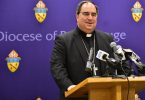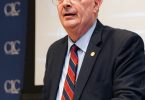
by Jim Lackey
A century ago, Catholic News Service began helping a burgeoning Catholic press to report on church activities around the globe.
And 100 years later, CNS has the same goals — to serve its client news outlets by reporting fully, fairly and freely on the church in the world today.
Or, to put it another way, the word “service” in its name is just as important as the words Catholic and news.
The U.S. bishops’ conference — today known as the U.S. Conference of Catholic Bishops but then known as the National Catholic Welfare Council, or NCWC — founded the news service in 1920. But history shows that it wasn’t totally the bishops’ idea.
Nine years earlier, in 1911, Catholic editors and publicists gave birth to the Catholic Press Association after years of discussions. Its goals were typical for a trade association — two of them were to “secure national advertising and agitate against higher postal rates.”

But a third goal was to develop a news service for Catholic papers.
Running a news service wasn’t easy, though. So in 1920, delegates to the Catholic Press Association’s convention agreed unanimously to accept an offer from the bishops’ conference to transfer the service to the NCWC. One account at the time said the agreement left the association “in a stronger position to carry out other activities for the welfare of the Catholic press.”
It also marked the first act of what would become a lifelong informal partnership between the association and the news service.
Justin McGrath, an experienced newspaperman who had been hired by the NCWC as the news service’s first director, explained how his agency would strengthen the association’s previous work for Catholic papers.
The association’s foreign news report “had been limited to a Rome cable and a London letter,” he wrote in a 1920 article publicizing the new NCWC News Service. But, he added, the news service shortly after its establishment was publishing material from Rome, Paris, London and Dublin. It planned to expand to Berlin and Vienna and offer occasional correspondence “from all the countries of South and Central America,” he said.

But why was the bishops’ conference interested in housing a news service for the Catholic press? The most important reason was the U.S. church’s experience during the First World War — known simply as the “Great War” because of its enormous scale.
As America entered the war in 1917, the U.S. bishops established a National Catholic War Council. The bishops didn’t want to be on the war’s sidelines but wanted to “help lead Catholic efforts in various areas of needs,” one observed years later.
After the war ended, American bishops favored continuing the war council’s work, such as coordinating Catholic response to reconstruction. So they voted to replace the war council with the National Catholic Welfare Council. (Shortly thereafter, the word “Council” was changed to “Conference.”)
At the same time, the bishops issued an ambitious pastoral plan for the social reconstruction of American society. Their landmark 1919 pastoral letter included praise for the “special value” of the Catholic press for the church in America. “As a means of forming sound public opinion, it is indispensable,” they said.

In his 1920 article, McGrath explained that the work of the National Catholic War Council during the world conflict “demonstrated beyond question the necessity of a regular national press service to safeguard the public interests of our Catholic people.”
Had the news service existed when the war council was formed, McGrath added, “much of its work could have been more easily explained to the Catholics of the country, and popular interest and cooperation in its many problems could have been more readily obtained.”
In spring 1920, the NCWC organized a Department of Publicity, Press and Literature “for the purpose of promoting Catholic journalism and literature at home and abroad.” Its first aim, the NCWC reported, was “the development of a strong central news bureau for the purpose of supplying the Catholic press of the United States with fresh, interesting and accurate news of Catholic interest the world over.”

The 1911 birth of the CPA also likely played a role. The first NCWC general secretary, Paulist Father John J. Burke, was among those who helped found the press association when he was editor of Catholic World magazine in New York.
The first edition of the weekly NCWC News Service was dated April 11, 1920. It included greetings and well-wishes from Pope Benedict XV as well as stories on upcoming canonizations in Rome (Joan of Arc was elevated to sainthood only a month later, on May 16), a U.S. Census Bureau report indicating that American Catholics had grown to a third of the U.S. population, and the renewal of diplomatic relations between France and the Vatican.
For the first dozen years, the news report consisted of a news sheet laid out like a typical newspaper front page of the 1920s and several additional pages of news typed with a manual typewriter. The news sheet format was abandoned in 1932, but by then the service was being issued three times a week with anywhere from four to 47 single-spaced legal-size pages per issue.
From the beginning, McGrath recognized the importance of timely distribution of the news service’s work to Catholic papers. He noted that the weekly news report was mailed from Washington to recipients in the Eastern U.S. But it also was telegraphed to The Catholic Telegraph in Cincinnati and to The Monitor in San Francisco for quicker mailing to Midwest and West Coast recipients.
Canadian Catholic papers also were interested in the service, and McGrath reported negotiations were underway to arrange cabling the service to Montreal for distribution throughout Canada.
Another goal for the news service was to be financially self-sustaining, and building a list of paying clients was one way to do that.

Professionalism was a key characteristic of the NCWC News Service. McGrath brought in a team of editors and reporters from leading U.S. dailies to cover the turbulent news of the decade, such as the resurgence of the Ku Klux Klan, the candidacy of Al Smith for U.S. president, the story of communist persecution in Russia, and the civil strife over British rule in Northern Ireland.
Bishop Philip R. McDevitt of Harrisburg, Pennsylvania, chairman of the bishops’ press department, summarized the news service’s philosophy in 1927. He said its main purpose was to provide Catholic newspaper editors with “full and accurate reports of happenings of interest to Catholics.”
He also said that because Catholics had freedom of opinion on “many subjects outside of the specific and definite teachings of the church,” the news service should be providing subscribers with factual information to help them “deal intelligently with questions which are open.”
From the start, the international coverage of the news service was extraordinary, shedding light on, among other things, the struggles in Europe against fascism and communism.
Coverage of refugees and immigration was a hallmark of its coverage — as it is today. In the 1920s alone, over 300 NCWC stories with straightforward reporting told of the world’s refugees displaced by wars and other strife.
Even its reporting on the U.S. church reflected the political passions of the day without taking sides. Read, for instance, this lead sentence from a 1947 story about a Pennsylvania bishop responding to criticism of the church. The lead — though far too wordy — could have been written many times in CNS history, except for the surprise turn in its last dozen words:
SCRANTON, June 12 (NC) — Bishop William J. Kafey of Scranton, replying to two groups of Protestant clergymen who had assailed remarks he made in an address here, has advised them in a letter that their “fears are imaginary” that the Catholic Church is seeking tax funds for the maintenance and expansion of its parochial school system, but that they should not underestimate the value of their anti-Catholic utterances to the communists.
The news service in 100 years has carried three names. First it was NCWC News Service. And though it often was referred to as NC News Service as early as the 1940s, it didn’t officially change its name to National Catholic News Service until 1966.
In 1989, the word “National” was dropped to reflect the service’s international circulation and coverage. It became simply known as Catholic News Service, or CNS. “We want editors abroad to not be misled by a name like ‘National,’ which only tells part of our story,” it announced.
One place the news service shined was coverage of the Second Vatican Council in 1962-65. CNS provided some of the most comprehensive English-language coverage of council sessions. A compilation of its reporting, along with the council’s working documents and proceedings, was later published in a three-volume set known simply as the Council Daybook.
And who can forget the remarkable reign of St. John Paul II? No one had seen a pope who traveled the world as much as he did, and yet the news service was with him on every step of the way.
The news service also has played a major role in helping its clients inform readers about the suitability of motion pictures and TV programs. First with the National Catholic Office for Motion Pictures (formerly the Legion of Decency) and then with the newly formed Office for Film and Broadcasting of the USCCB, CNS served as distributors of media review materials quite popular with clients and their readers. In 2010, the office’s work was absorbed into CNS as part of a USCCB restructuring.
The past century has been filled with other landmarks:
— After 53 years of relying on mail to distribute its work to its clients, it began offering a teletype service in 1973, which would transmit stories to editor’s offices immediately, making CNS a true “wire service” for the Catholic press. Wire transmissions were replaced in the 1980s by transmission of stories via satellite signal and then by postings on a password-protected site, www.catholicnews.com, in 1999.
— In 1972, nonmanagement employees of the news service voted to join the Washington-Baltimore Newspaper Guild, meaning that their salaries and benefits have been collectively bargained for nearly 50 years.
— In the past decade, CNS has joined the trend of visual storytelling through news videos distributed on YouTube. Related print news stories are transmitted to CNS clients with instructions on how to embed the video segment with the CNS story in client websites.
— Also over the past decade, the Catholic Research Resources Alliance has been collecting digital archives of Catholic news resources, including Catholic News Service. To see CNS stories from 1920 to 1985, visit http://bit.ly/32QDwrv.
Catholic News Service has continued to follow those professional precepts for 100 years. For instance, it never has taken a position on issues such as altar girls or on the authenticity of the reported Marian apparitions at Medjugorje — it merely reports the opinions of those who do. Being a service to its client news outlets requires it to do so.
Even difficult church issues — such as the sex abuse crisis — have been approached with professionalism and won awards for the service. In 2003, for instance, CNS reporter and former Rome bureau chief Jerry Filteau won the Catholic Press Association’s highest honor, the St. Francis de Sales Award, “for a career of uncompromising journalism in the service of the Catholic press,” especially on the abuse crisis.
Besides Filteau, others who have been given the association’s top honor primarily for their work at CNS include Frank A. Hall, Floyd Anderson, A.E.P. Wall, Thomas N. Lorsung, and Tony Spence, who all were successors of McGrath as directors of the news service; along with John Thavis, Jim Lackey and Julie Asher.
It’s another sign of the strong partnership the news service and the CPA — based in Chicago and recently renamed the Catholic Media Association — have displayed in their 100 and 109 years of existence. Another partnership is a Liaison Committee between the two organizations. That group meets annually to discuss avenues where the news service can better help its client publications.
In the early days of the news service, the then-president of the CPA called CNS “a godsend to the Catholic press.” And that’s still what CNS wants to be.






